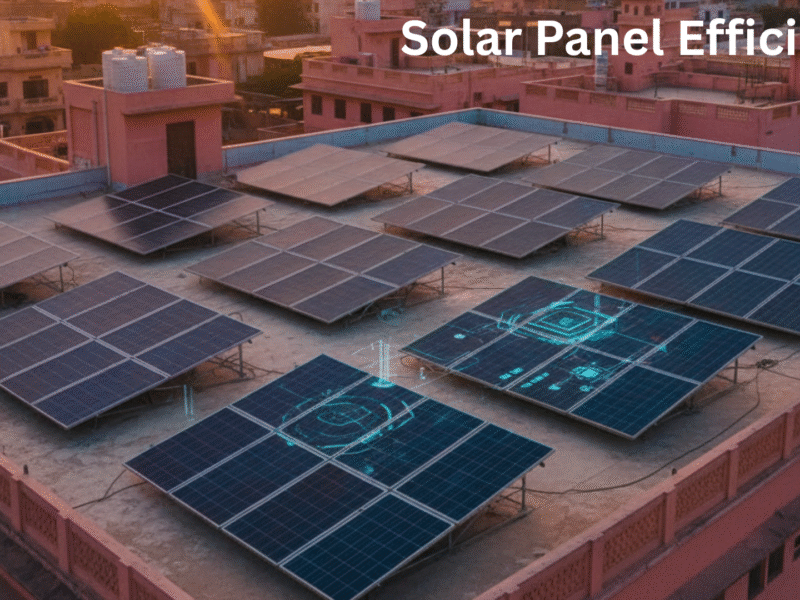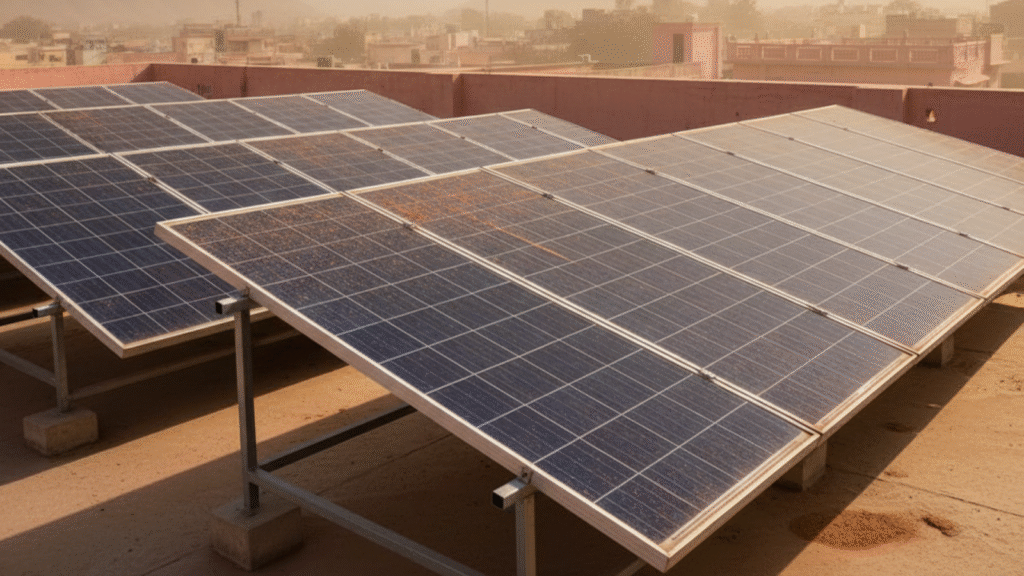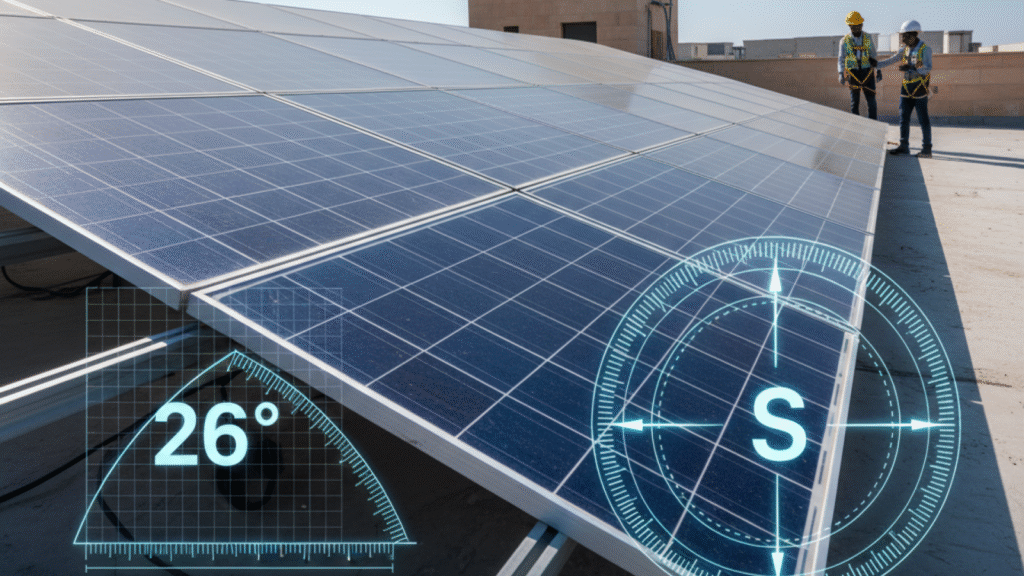
Jaipur, the majestic capital of Rajasthan, is a genuine solar powerhouse. Undoubtedly, the city is blessed with an exceptional abundance of sunlight, with over 300 clear, sunny days each year. On an average day, the region receives robust solar radiation, often exceeding 6 kWh/m2/day. This impressive irradiance lays a strong foundation for any solar investment. However, harnessing this potential requires more than just installing panels; one must actively focus on maximizing Solar Panel Efficiency.
For homeowners and commercial businesses, boosting efficiency is the direct path to a quicker Return on Investment (ROI) and a dramatic reduction in electricity bills. Therefore, this comprehensive guide will detail the technical strategies and maintenance practices necessary to unlock your system’s peak performance in Jaipur’s unique climate.
The Core of Solar Panel Efficiency

Defining “Solar Panel Efficiency” and Its Importance
Solar Panel Efficiency is the fundamental metric that determines your system’s output. Specifically, it is the percentage of sunlight solar energy that a photovoltaic (PV) panel converts into usable direct current (DC) electricity. For instance, a 22% efficient panel converts 22% of the incoming solar energy into power.
Ultimately, higher efficiency is paramount in an urban setting like Jaipur where rooftop space is a finite resource. By choosing panels with greater efficiency, you effectively generate a larger volume of electricity from a smaller area.
Technology Choice: Monocrystalline vs. Bifacial Modules
The choice of panel technology significantly impacts your long-term Solar Panel Efficiency. In Jaipur’s high-temperature environment, the standard Poly-crystalline panels are often outperformed.
| Panel Type | Efficiency Range | Key Feature for Jaipur | Recommendation |
| Monocrystalline PERC | High (19% – 22%+) | Superior performance in heat; better space utilization. | Excellent. A reliable benchmark for most residential installations. |
| Bifacial / TOPCon | Highest (22% – 24%+) | Generates power from the front and back side; ideal for high-albedo (reflective) surfaces like white-painted rooftops. | Premium Choice. Offers maximum energy yield, especially in large, clear installations. |
In short, high-quality mono PERC or bifacial panels should be selected to maintain power output even when temperatures soar.
Overcoming Jaipur’s Climate Challenges to Boost Solar Panel Efficiency

Jaipur’s arid and high-temperature climate presents two primary obstacles to peak Solar Panel Efficiency: thermal degradation and dust accumulation.
Managing Thermal Degradation from Extreme Heat
Jaipur’s summer mercury frequently hits 40∘C and higher. Crucially, high heat directly impacts solar panel performance.
- The Technical Reality: Every panel has a Temperature Coefficient (e.g., −0.35%/∘C). This indicates that for every degree above the standard test temperature (25∘C), the panel’s power output decreases by that percentage.
- Active Mitigation: To combat this, installers must prioritize excellent airflow. Therefore, a minimum gap of 4 to 6 inches must be maintained between the panel frame and the rooftop surface. This simple measure allows convective cooling to take place, significantly lowering the module’s operating temperature.
- Smart Inverter Technology: Furthermore, integrating Maximum Power Point Tracking (MPPT) inverters or power optimizers is highly recommended. These devices continuously ensure the panel is operating at its peak voltage, minimizing power loss caused by fluctuating temperatures.
The Dust Soiling Menace: A Localized Threat
As a gateway to the Thar desert, Jaipur experiences frequent dust storms and heavy soiling. Consequently, dust accumulation is the single greatest cause of reduced Solar Panel Efficiency in the region. Dust layers block sunlight, leading to losses that can reach 15% to 25% during dry, windy periods.
- The Maintenance Strategy: An effective cleaning regimen is non-negotiable. Ideally, during the peak dry months (April to June), panels should be cleaned every 7 to 10 days. Rain naturally washes the panels during the monsoon, but after this season, a thorough cleaning is mandatory to remove caked-on residue.
- Cleaning Best Practice: Use soft water and a specialized non-abrasive solar cleaning tool. It is essential that hard water and abrasive brushes are avoided, as they can scratch the glass or leave mineral deposits, which permanently degrade performance.
Precision Engineering for Maximum Yield

Installation design, often overlooked, determines the system’s long-term Solar Panel Efficiency.
Optimizing the Tilt Angle for Jaipur’s Latitude
The panel’s angle is dictated by the city’s latitude (approx. 26.9∘ N) and is vital for capturing maximum perpendicular sunlight.
- The Fixed-Tilt Sweet Spot: The most practical and cost-effective approach is a fixed tilt. For Jaipur, a fixed angle between 25∘ to 28∘ is the optimal compromise for maximizing annual energy generation. Hence, most professional installations utilize structures set within this range.
- Directional Alignment (Azimuth): Furthermore, all solar arrays in the Northern Hemisphere must face True South (Azimuth 180∘). Any significant deviation compromises efficiency throughout the year.
Mitigation of Shading Losses
Even a small shadow can disproportionately reduce the output of an entire string of panels—a phenomenon known as the “Christmas Light Effect.” Therefore, a professional site survey must be conducted to identify potential shading from water tanks, parapet walls, and adjacent buildings during all hours of the day.
- Technology to the Rescue: In cases where shading is unavoidable, micro-inverters or DC Optimizers should be used. These components ensure that only the shaded panel’s output is reduced, preventing the issue from affecting the entire system.
The Role of Net Metering in Financial Efficiency
While technically not a factor of panel efficiency, the use of a Net Metering system dramatically improves the financial efficiency and ROI of your investment in Jaipur. In essence, net metering allows you to export any surplus electricity your solar panels generate back to the local grid, earning you credits that offset your future electricity consumption. Consequently, a well-sized, high-efficiency system, when paired with net metering, can drastically reduce or even eliminate your monthly electricity bill.
Frequently Asked Questions (FAQ)
Q1. How much does dust reduce solar panel efficiency in Jaipur?
A. Dust accumulation, especially during the dry summer months, can reduce Solar Panel Efficiency by anywhere from 10% to 25% if cleaning is neglected. Regular cleaning every 7-10 days in peak summer is essential to minimize these losses.
Q2. Is high efficiency worth the extra cost for a Jaipur rooftop?
A. Yes, it is often worthwhile. Since urban rooftop space is often limited, investing in panels with higher Solar Panel Efficiency (like Monocrystalline or Bifacial) allows you to generate more energy per square foot. This, in turn, accelerates your return on investment (ROI), making the higher upfront cost financially sound in the long run.
Q3. Do solar panels work less effectively in Jaipur’s extreme summer heat?
A. They do, but only slightly. High temperatures above 25∘C cause a minor drop in Solar Panel Efficiency due to the temperature coefficient effect. To combat this, ensure your installer uses a raised mounting structure to maximize airflow and look for panels with a lower temperature coefficient.
Q4. Which direction should solar panels face in Jaipur?
A. For maximum annual Solar Panel Efficiency, your panels should face True South (Azimuth 180∘). This orientation ensures the highest exposure to direct sunlight throughout the day and the year.
Conclusion: Securing Your Future with Maximum Solar Efficiency in Jaipur
The sheer solar potential of Jaipur is undeniable. However, a successful solar journey hinges on a comprehensive strategy that prioritizes Solar Panel Efficiency. By making informed choices on panel technology, insisting on optimal installation angles, and committing to a rigorous, localized maintenance schedule, residents and businesses can overcome the unique challenges of the Rajasthani climate. Ultimately, adopting these best practices ensures that your solar system operates at its peak, guaranteeing a stable, significant financial return and a cleaner energy future for the Pink City.

